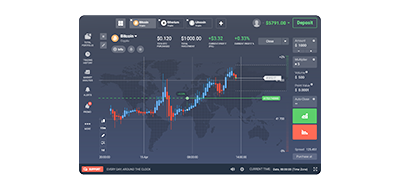Voltar
Contents
The Best Futures Trading Strategies for 2025

Trading

Demetris Makrides
Senior Business Development Manager

Vitaly Makarenko
Chief Commercial Officer
As we enter 2025, the futures trading landscape is evolving rapidly, driven by technological advancements, shifting economic conditions, and geopolitical uncertainties. With increased market volatility and algorithmic trading playing a bigger role, traders must refine their strategies to stay ahead. The best futures trading strategies in 2025 will be those that adapt to changing market conditions, leverage data-driven insights, and manage risk effectively.
In this guide, we’ll explore the top futures trading strategies for 2025, from adaptive trend following to quantitative order flow analysis. Whether you’re a seasoned trader or just starting out, these strategies can help you optimize your trades, navigate market fluctuations, and maximize profits.
Futures Trading Strategies Shortlist
- Adaptive Trend Following
- Spread Trading Strategy
- The Pullback Strategy
- Breakout Trading Strategy
- Precision News Trading
- Volatility Harvesting
- Quantitative Order Flow Analysis
Adaptive Trend Following
Building upon traditional trend-following methods, adaptive trend following emphasizes flexibility in response to market volatility. By utilizing dynamic indicators and adjusting parameters in real-time, traders can better capture emerging trends and mitigate risks associated with sudden market reversals. This approach is particularly relevant in 2025, as markets are expected to experience rapid shifts due to technological disruptions and geopolitical tensions.
One major advantage of trend following is that it eases the emotional pressure of consistently attempting to perfectly time market entries and exits by using a system based on rules that adjusts as the market changes over time. During a bullish market phase traders may opt to increase their position sizes; however during bear phases they could reduce positions or shift towards short selling opportunities.
Spread Trading Strategy
To profit from the price differential between two linked futures contracts, a strategy known as pairs trading or spread trading is employed. Futures contracts tied to correlated assets, such as commodities or indices, can see varied price movements over time, making this method particularly beneficial in these markets.
You may also like

Calendar spread trading involves simultaneously buying and selling futures contracts of the same underlying asset but with different delivery dates. This strategy allows traders to profit from changes in the spread between the two contracts, effectively managing risks associated with time-based price fluctuations. For instance, a trader might take a long position in a crude oil futures contract expiring in June while shorting a contract expiring in December, aiming to benefit from anticipated changes in supply and demand dynamics over the period.
The Pullback Strategy
The pullback approach aims to capitalize on short term shifts within a trend by waiting for the market to retreat to a support or resistance level before entering a trade aligned with the prevailing trend direction. This tactic demands patience and accurate timing to differentiate between a pullback and a potential shift in trend direction.
In 2024, this strategy will work well in markets that experience large price swings followed by small corrections before resuming their original trajectory. Trading chances may be seized at better prices and profit potential maximized when trends take up again if traders research market movements and use tools like Fibonacci retracement levels, Relative Strength Index (RSI), or moving averages.
Breakout Trading Strategy
Breakout trading stands out as a favored strategy in futures trading due to its ability to take advantage of price shifts that happen when a market moves beyond a range, effectively breaking out of it. A breakout happens when the price pushes through a support or resistance level and typically comes with high trading volume, which indicates the likelihood of a significant move in one direction.
Breakout trading focuses on identifying key support and resistance levels and executing trades when prices break through these thresholds. In 2025, with markets potentially influenced by rapid technological changes and global events, breakout trading can help traders capitalize on significant price movements. For example, if a stock index consistently faces resistance at a certain level, a breakout above this point, accompanied by increased volume, may signal a strong upward trend.
Precision News Trading
With the acceleration of information dissemination in 2025, precision news trading has become increasingly vital. This strategy involves making trades based on immediate reactions to economic releases, corporate announcements, or geopolitical events. Utilizing advanced algorithms and real-time data feeds, traders can swiftly respond to news, positioning themselves advantageously ahead of broader market movements. For instance, unexpected changes in interest rates or employment figures can lead to rapid price adjustments in related futures contracts.
In today’s fast paced world of data and quick market responses sophisticated news trading is gaining importance. This approach entails making trades in response to economic occurrences, corporate disclosures and global happenings that could lead to substantial shifts in futures market prices.
Traders should keep an eye on financial calendars and important data releases like interest rate decisions, employment reports and inflation updates that could lead to sudden price changes. News traders should be ready to execute trades often using algorithms or specific software to respond to news immediately upon its release. Effective risk management is crucial in news trading since markets can undergo significant volatility during and after major announcements.
Volatility Harvesting
The core idea behind the volatility harvesting approach is to profit from market price swings regardless of their direction. Markets that are very volatile, where prices move a lot in either way, provide opportunities for long and short trades. The strategy involves executing trades for buying and selling futures contracts during periods of increased volatility without maintaining a strong viewpoint or position on market direction, basically remaining neutral.
Volatility harvesting aims to exploit market price swings, regardless of direction. In the context of 2025’s anticipated market fluctuations, this strategy involves executing both long and short trades during periods of increased volatility, without a strong bias toward market direction. Tools like the Volatility Index (VIX) can help traders identify optimal entry and exit points, allowing them to profit from the inherent uncertainty in the markets.
Quantitative Order Flow Analysis
In futures markets where large institutional traders can affect market dynamics with their significant orders, quantitative order flow analysis approach depends critically on the analysis of buy and sell orders in the market to anticipate price changes. Traders are able to acquire insight into the market state and anticipate future price movements by monitoring order flow data, which includes market depth and transaction volumes. This allows traders to anticipate future price movements before they are reflected in the broader market.
As frequency trading tools and advanced analytics become more accessible in the realm of futures trading, quantitative order flow analysis is set to become a crucial element. Traders who can interpret this data skillfully will have the ability to predict changes in market momentum and adjust their positions accordingly. It is possible for this strategy to have an even greater impact when it is combined with other tactics such as trend following or breakthrough trading.
Backtesting Your Futures Strategy
Futures traders must verify the practicality of their approach before placing real money at risk by testing data against a trading plan. A straightforward explanation of backtesting is applying a selected trading plan to past market data to assess its performance over time. This method allows traders to evaluate the profitability of their strategies, identify any shortcomings and make improvements for optimal outcomes.
Traders must have historical data sources generally available through trading platforms or outside services providers if they want to adequately test a futures trading strategy from the past time frame. First step in starting this process is first entering the rules of the strategy into a backtesting program. If you are trying a trend-following strategy, for instance, you might specify criteria such as moving averages or volatility indicators to guide entrance and exit locations. The system then simulates how the strategy would have performed in various time periods based on historical data and produces analysis like win to loss ratios, profits and losses.
It’s important to remember that past performance is not always indicative of future results because circumstances in the market can shift and factors like market fluctuations and economic trends might impact how effective a strategy will be moving forward. When testing your approach against past data, it’s wise to avoid making it overly tailored or perfectly optimized to fit previous trends because this could lead to setting unrealistic expectations. The aim is to uncover a strategy that works consistently well overall in all market scenarios rather than just in certain time periods.
Developing a Futures Trading Plan
To succeed in the chaotic field of futures trading markets, you must create a thorough strategy, including your objectives and risk tolerance, together with your trading strategies and techniques for responsible and efficient transaction management in many market circumstances.
Start by stating your financial objectives. Do you intend to invest in futures for the purpose of building long term wealth? Are you more interested in pursuing shorter term speculative profits? Your objectives will directly impact the strategies you choose to follow and the level of risk you’re comfortable with taking.
You should not anticipate to make a killing on every stock or investment trade; so, it is essential to set reasonable goals for your potential gains. Your risk tolerance is key here. This means figuring out how much of your investment portfolio you’re comfortable risking on each trade and your overall exposure to risk. Generally speaking, try not to expose too much of your money to risk; nothing above 1 to 2 percent of your capital on any one trade can help you manage losing streaks without totally emptying your account.
Your trading strategy should also detail the approaches and strategies you plan to employ like following trends or trading breakouts or spreads. Clearly state the parameters for entering and exiting trades as well as guidelines for adjusting your tactics in response to market changes such as transitioning from active trading in bullish markets to a more cautious approach in volatile or uncertain circumstances.
Make sure to include your trading routine in your plan. This would include things like keeping up with the latest market news and studying charts while reflecting back at your past trades for lessons, from both wins and losses. This structured method helps ensure that your trades match your objectives and risk management standards.
Managing Risks in Futures
Trading in futures markets requires a high level of risk management in order to protect your investment and ensure sustainable returns over time. Even small price changes can have a significant impact on your profits or losses because of the leverage ratios.
Stop loss orders are a risk management tool in futures trading. They cause a contract to be automatically closed if the market goes against you by a certain percentage, limiting your potential losses. In the case of buying crude oil futures, setting a stop loss five percent below your entry point, the trade would close should the market reach that level. This strategy helps you avoid continuing to follow losing trades for a too long period. In order to minimize heavy losses in unpredictable markets, futures traders must determine the appropriate position size by assessing the size of each position relative to their total account and risk tolerance level.
Managing risk effectively entails diversification of investments across assets rather than focusing on a single asset or asset class in trading activities such as spreading exposure across several futures contracts. This allows traders to reduce the impact of negative market developments in any specific industry and protect against unforeseen events.
In addition to that said above, risk management is also about having a grasp of market situations. Keeping up to date with economic changes and events like shifts in interest rates or global politics helps you tweak your risk strategies as needed. During times when the market’s highly unstable, you might opt to decrease your trade sizes or temporarily step back until things settle down.
By integrating these risk management techniques into your trading approach, you can safeguard your investments effectively and minimize potential losses while boosting your overall results in futures trading.
Conclusion
The futures trading environment in 2025 demands adaptability, informed decision-making, and robust risk management. By integrating these updated strategies, traders can position themselves to effectively navigate the complexities of the modern market landscape, leveraging opportunities while mitigating potential risks.
Atualizado:
20 de janeiro de 2025
12 de março de 2025
NEW POST FOR TESTING BLOG AND WP
What is Lorem Ipsum? test link with http Lorem Ipsum is simply dummy text of the printing and typesetting industry. Lorem Ipsum has been the industry’s standard dummy text ever since the 1500s, when an unknown printer took a galley of type and scrambled it to make a type specimen book. It has survived not only […]



